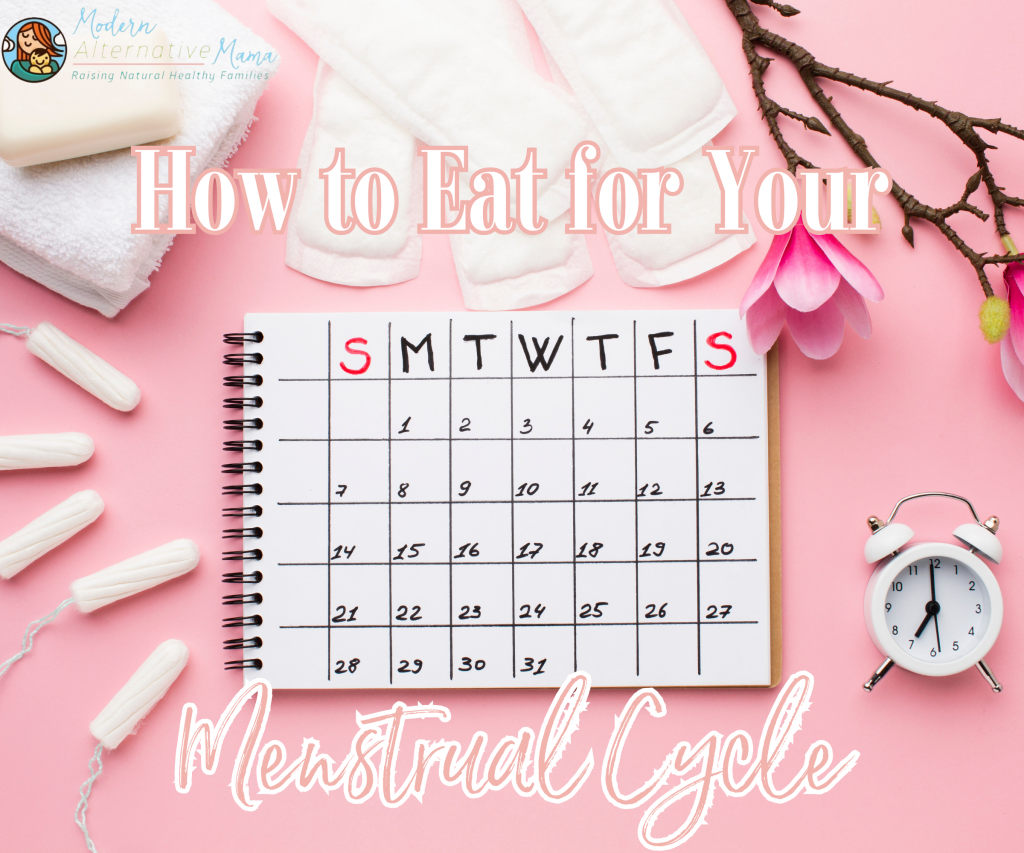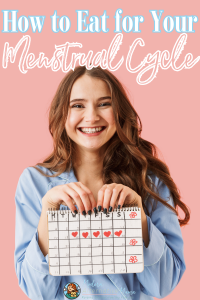I have always struggled with an irregular menstrual cycle but have never actually done anything to counteract it. I have struggled with hormone imbalances, irregular periods, and ovarian cysts. Of course, over the years, I have been prescribed birth control, which was an utter disaster, and I have even been diagnosed with hormonal acne. The problems kept piling up, but no doctor ever educated me on what was normal and what wasn’t. No one ever told me about cycle syncing.
A woman’s menstrual cycle is so much more than the 2-7 days of menstruation each month. The average length of a woman’s cycle can vary, but it’s typically the same length as the lunar month, 28 days. A cycle starts the first day of a woman’s period, ends the day before her next period, and typically lasts between 23 and 35 days (1).
Four Phases of a Menstrual Cycle
There are four phases to a women’s cycle: menstruation, follicular, ovulatory, and luteal. Each of these phases plays a specific role in a woman’s body, and believe it or not, there are foods you can eat to support your body and overall health.
Menstruation
The menstruation phase is actually the beginning of the follicular phase. This phase begins a women’s cycle and typically lasts 1 to 5 days. During this phase, the lining of the uterus, the endometrium, is thick with fluids and nutrients designed to nourish an embryo. If an egg hasn’t been fertilized, it sheds, causing bleeding, often called a period. Estrogen and progesterone are low at this point of a woman’s cycle (2).
During the menstruation phase, it’s best to avoid or limit fatty foods, alcohol, caffeine, and salty foods, as these will increase inflammation in the body, which causes menstrual cramps and PMS (3). Instead, you can incorporate anti-inflammatory foods and herbs that boost estrogen and progesterone. Some foods and herbs you can incorporate during the menstruation phase are:
- Alfalfa (4) – check out our alfalfa herbal profile
- Berries (5)
- Broccoli (6)
- Cinnamon (7) – check out our cinnamon herbal profile
- Dark chocolate (8) – check out the health benefits of dark chocolate
- Flaxseeds (9)
- Garlic (10) – check out our garlic herbal profile
- Licorice root (11) – check out our licorice root herbal profile
- Peaches (12)
- Schisandra (13) – check out our Schisandra herbal profile
- Wheat bran (14)
During the menstruation phase, you may experience premenstrual syndrome (PMS) symptoms like menstrual cramps; magnesium supplementation may help (15). I highly recommend a topical magnesium supplement like Earthley’s Good Night Lotion. Another great option is Earthley’s Ease The Ache, which uses the natural power of cramp bark, red raspberry leaf, motherwort, and nettle to help relieve unbalanced hormones, pain, bloating, heavy bleeding, and more.
Follicular
The follicular phase typically occurs from days 6 to 14 of a woman’s cycle. Since the menstruation phase is a part of the follicular phase, it technically occurs for about 14 days, making it the longest phase of a woman’s cycle. The follicular phase can range from 14 to 21 days, and the length of the follicular phase may vary at different stages of life. During this part of the follicular phase, fluid-filled sacs in your ovaries, called follicles, house around 11 to 20 immature eggs. As the eggs develop, only the biggest, healthiest, and most dominant follicle matures completely. As the dominant follicle matures, so does the egg inside that will eventually be released during the ovulatory phase. As the dominant follicle matures, it releases more estrogen and progesterone, helping to replenish what was lost during menstruation (16).
Just like during the menstruation phase, it’s best to avoid inflammatory foods during the follicular phase. During this part of the phase, instead of boosting estrogen, we want to incorporate foods that metabolize estrogen to ensure an overproduction of estrogen or estrogen dominance doesn’t occur (17). Focus on fiber-rich foods and cruciferous vegetables, which are vegetables of the Brassicaceae or Cruciferae family (18). Some foods and herbs you can incorporate during the follicular phase are:
- Arugula (19)
- Broccoli (19)
- Brussels sprouts (19)
- Burdock root (20) – check out our burdock herbal profile
- Cabbage (19)
- Cauliflower (19)
- Dandelion (21) – check out our dandelion herbal profile
- Kale (19)
- Raspberry leaf (22) – check out our red raspberry leaf herbal profile
This phase is a great time to add sprouted and fermented foods like broccoli sprouts, kimchi, and sauerkraut. Additionally, focus on vitamin D, which is crucial to estrogen regulation (23). I recommend soaking up the sunlight or a topical supplement like Earthley’s Vitamin D Cream.
Ovulatory
The ovulatory phase of a woman’s cycle typically occurs on day 14 of a woman’s cycle. During the ovulatory phase, the ovary releases an egg (ovum). Once an egg leaves the ovary, it travels down the fallopian tube, where it waits to be fertilized by sperm. The egg only survives 12 to 24 hours after ovulation. During the ovulatory phase, estrogen rises to peak levels; testosterone and progesterone levels also increase, making this phase the most fertile time of a woman’s cycle. If sperm doesn’t fertilize the egg, the body reabsorbs it, and the luteal phase starts (24).
With estrogen at an all-time high during the ovulatory phase, eating foods that support the liver is crucial. Focus on anti-inflammatory foods like whole fruits, vegetables, and nuts. They pack incredible health benefits, including anti-aging and antioxidant properties that protect from environmental toxins, which are known to impact your hormones (25). Some foods and herbs you can incorporate during the ovulatory phase are:
- Astragalus (26) – check out our astragalus herbal profile
- Beets (27)
- Blueberries (28)
- Cranberries (29)
- Ginger (30) – check out our ginger herbal profile
- Grapefruit (31)
- Grapes (32)
- Nuts (33)
- Peppermint (34) – check out our peppermint herbal profile
- Turmeric (35) – check out our turmeric herbal profile
During the ovulatory phase, you may want to add Earthley’s Liver Love for additional liver support. Liver Love combines liver-supporting herbs like turmeric root, milk thistle seed, dandelion root, peppermint leaf, and black pepper to support detox and proper function.
Luteal
The luteal phase starts on day 15 of a woman’s cycle. During the luteal phase, hormone levels start high as the body prepares the uterus for pregnancy by thickening your uterine lining. If the egg isn’t fertilized, hormone levels decrease as the body prepares for the menstruation phase again, typically on day 28 of a woman’s cycle. The average length of the luteal phase is between 12 and 14 days, but anything between 10 and 17 days is considered normal (36).
During the luteal phase, estrogen and progesterone both surge and then wane, so it’s best to avoid alcohol, carbonated drinks and artificial sweeteners, red meat, dairy, and added salt. Instead, focus on magnesium-rich foods that produce serotonin to fight fatigue and low libido. Some foods and herbs you can incorporate during the ovulatory phase are:
- Bananas (37)
- Basil (38) – check out our basil herbal profile
- Fennel seed (39) – check out our fennel herbal profile
- Passionfruit (37)
- Pineapples (37)
- Nettle (37) – check out our nettle herbal profile
- Sage (40) – check out our sage herbal profile
- Spinach (37)
- Strawberry (37)
Every phase of a woman’s menstrual cycle plays a crucial role in not just women’s health, but overall health. It’s important to ensure proper nutrition is achieved during each phase and that the needs of our bodies are met.




so is there just no time in the cycle that is safe to have fatty food, alcohol, or caffeine?
Thank you so much for this great question. The woman’s body is very particular, and imbalances can happen easily, which is why fatty foods, alcohol, or caffeine typically aren’t ideal. Of course, moderation is key, and healthy fats are crucial, but everyday consumption can be problematic. If you have any particular concerns, I’d be happy to help find hormone-friendly alternatives. 🙂